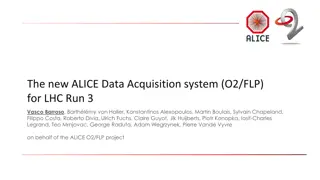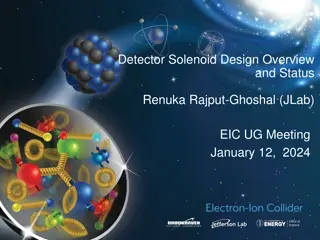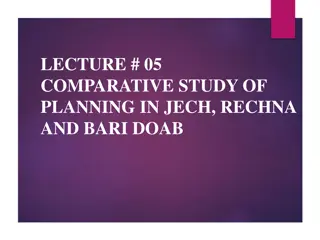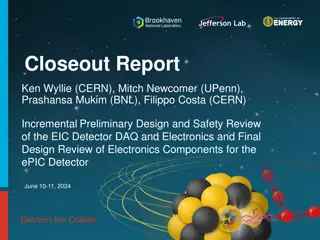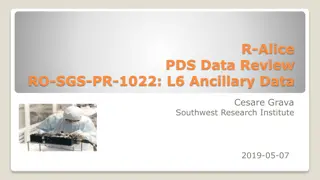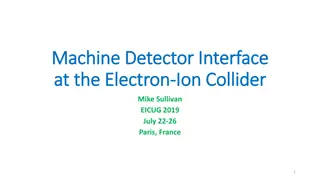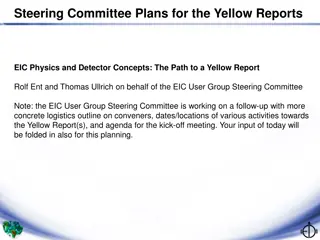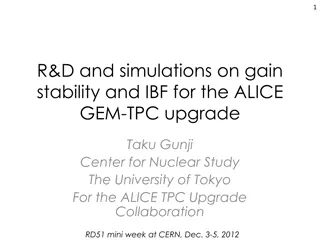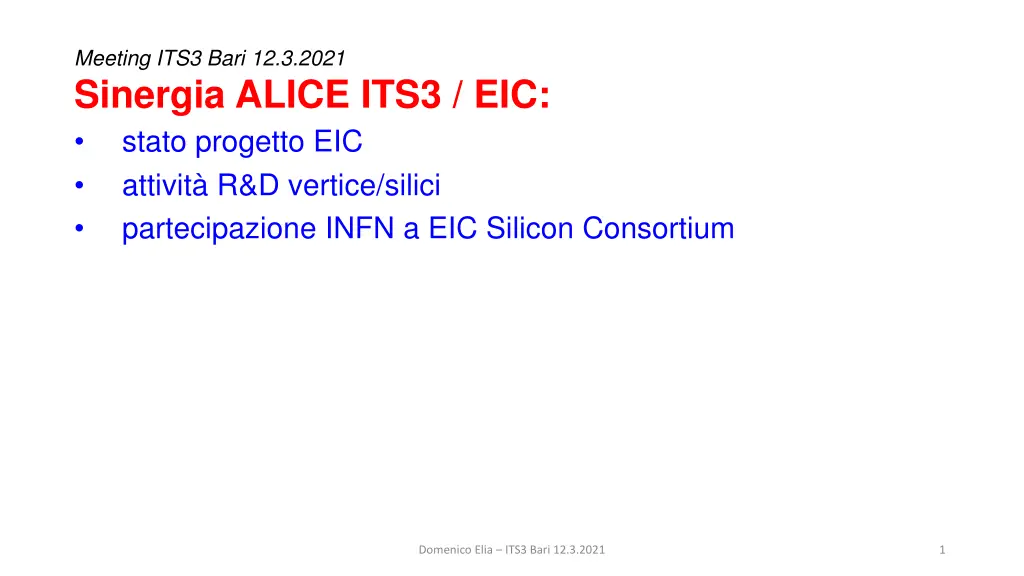
EICSC Meeting Summary and Detector Concepts
Explore the details of the EICSC meeting held in Bari on 12th March 2021, discussing the progress and plans regarding the EIC project, R&D activities, sensor requirements, and detector concepts developed during the Yellow Report exercise. Learn about the synergy with CERN's ITS3 effort, the involvement of INFN in the EIC Silicon Consortium, and the essential role of MAPS silicon detectors in tracking at the EIC.
Download Presentation

Please find below an Image/Link to download the presentation.
The content on the website is provided AS IS for your information and personal use only. It may not be sold, licensed, or shared on other websites without obtaining consent from the author. If you encounter any issues during the download, it is possible that the publisher has removed the file from their server.
You are allowed to download the files provided on this website for personal or commercial use, subject to the condition that they are used lawfully. All files are the property of their respective owners.
The content on the website is provided AS IS for your information and personal use only. It may not be sold, licensed, or shared on other websites without obtaining consent from the author.
E N D
Presentation Transcript
Meeting ITS3 Bari 12.3.2021 Sinergia ALICE ITS3 / EIC: stato progetto EIC attivit R&D vertice/silici partecipazione INFN a EIC Silicon Consortium Domenico Elia ITS3 Bari 12.3.2021 1
Meeting ITS3 Bari 12.3.2021 Sinergia ALICE ITS3 / EIC: stato progetto EIC: approvazione iniziale e scelta sito (BNL) a inizio 2020 (CD-0) EoI delle singole istituzioni sottomesse a Maggio 2020: comunit INFN (EIC_NET) coinvolta su PID, Vertex (+streaming R/O e SW) preparazione Yellow Report nel 2020, finalizzata a inizio 2021 YR input per CD-1 (atteso in primavera) appena pubblicata la Call for detector proposal (proposte entro 1/12/2021) formazione di proto-collaborazione / consorzi, oggi lancio di una iniziativa per IP6 R&D 2021-2024, costruzione 2025-2029 esperimento in presa dati per ~2030 attivit R&D vertice/silici: basata su MAPS e con sovrapposizioni rilevanti con ALICE ITS3 EIC Silicon Consortium attivo come casa comune, anche per Detector proposal gruppi ALICE interessati: per ora BA e TS (Contin) qualche elemento nelle prossime slide (L. Greiner @ EICSC 4.2.2021) Domenico Elia ITS3 Bari 12.3.2021 2
Some results from the YR exercise Two tracking detector scenarios developed All silicon concept: Hybrid Silicon + gaseous detector tracking: Both of these scenarios require a large effort to construct ~ 10 m^2 of MAPS silicon detectors 2021_02_04 EICSC meeting - LG 3
EICSC need Tracking / Sensor requirements: Currently only MAPS meet this requirement. The newly defined size of the beam pipe shows the need for the sensor pixel size to be < 20 um to meet central tracking requirements. Other sensor candidates either can not be modified to meet the requirements or do not appear to have sufficient support to be available by the time needed. The path of using synergy with the CERN ITS3 effort is the best path to success. The EICSC goal of developing a full detector solution using sensors based on the ITS3 design is a critical and time sensitive effort for tracking at the EIC 2021_02_04 EICSC meeting - LG 4
Yellow Report driven detector concepts As part of the YR exercise, detector concepts were developed and optimized for EIC tracking. These concepts drive the direction that is needed to move forward in sensor and detector development to realize these concepts. Conceptual layouts are presented below Vertexing inner layers are based on the ITS3 development at CERN BUT the length of the inner staves and the diameters at which these layers sit are markedly different from the ITS3 base design ITS3 length = 30 cm. This is set by the length of stitched sensors on a 12 wafer. EIC length (hybrid) = 42 cm ITS3 radii = 18 mm, 24 mm, 30 mm these radii are set by the integer width of rows of stitched sensors. EIC radii = 36.4 mm and 44.5 mm EIC strawman design (modification of ITS3) Reach larger radii by using 3 bent sections Services exit from both sides of inner layers Engineering work needs to begin 2021_02_04 EICSC meeting - LG Services exit from one end 5
Yellow Report driven detector concepts Staves and discs will be based on a forked EIC specific sensor design based on the ITS3 sensor. The primary concern is yield for long rows of stitched sensors. The plan is to assess yield in the first engineering run and adjust the EIC sensors to optimize yield for the number of stitched sensors in a row. Staves Use shorter lengths of stitched sensors to form staves. Power and signal will need to be propagated along the stave with flex PCBs over the stave length. DC-DC converter? Flex PCB for power/signal Power/signal exit Stitched sensors Stave support structure Discs - could be formed with overlapping staves that conform to the disc diameters or with sensors mounted to half- disc low mass plates. For both of these solutions we will need to optimize the stitched sensor layout on the wafers to provide the right number of stitched sensor lengths to give the proper needed lengths for each stave/disc. This needs study and optimization. 2021_02_04 EICSC meeting - LG 6
Gross timeline (technical) 2021 Testing and characterization of MLR1 Sensor design for MLR2 or ER R&D into powering, stave/disc construction, cooling, overall infrastructure MLR2 submission 2022 - Testing and characterization of MLR2 Sensor design for ER R&D + prototyping into powering, stave/disc construction, cooling, overall infrastructure ER submission 2023 - Testing and characterization of ITS3 ER and assessment of yield Assessment and planning for EIC sensor fork of ITS3 design Fork off sensor design and work on EIC variant for staves and discs (may move to next year depending on results) Detailed prototyping into powering, stave/disc construction, cooling, overall infrastructure ER submission for EIC variant sensor for staves and discs (may move to next year depending on results) Investigation of adaptation of ITS3 design for use in EIC inner layers (different radii, # layers, services from both ends to meet length requirements, etc. 2021_02_04 EICSC meeting - LG 7
2024 Testing and characterization of EIC ER and assessment of yield Si design for EIC ER2 Detailed prototyping into powering, stave/disc construction, cooling, overall infrastructure using EIC ER1 prototypes. ER2 submission for EIC variant sensor for staves and discs adaptation of ITS3 design for use in EIC inner layers and integration of design into ER2 if necessary. We are developing two detector concepts: 1. ITS3 like for the vertexing layers. 2. EIC variant for the staves and discs. We will need to develop the capabilities to bring both detector concepts and the associated infrastructure to completion 2021_02_04 EICSC meeting - LG 8
Expanded task list for 2021 (applies to following years as well) These tasks compliment and are in addition to robust participation in the ITS3 work packages to prepare for the EIC vertexing layers design. 2021 Testing and characterization of MLR1 design of testing system that extends into the testing of the next submissions. Beam testing, Latch-up testing, SEU testing, radiation tolerance testing (kRAD, NIEL), firmware, software, mechanical carriers, alignment stations, analysis, etc. This work is starting in ITS3, we can/should join this effort. Sensor design for MLR2 or ER Inclusion of other silicon design sites into the design process (in progress), Assessment of the testing results and incorporation into the new designs, significant digital design (in pixel logic, readout structures and architecture), design for stitching, significantly more complex structures and pixel layout studies, design for yield, etc. R&D into powering, stave/disc construction, cooling, overall infrastructure Take up DC-DC converter and serial powering R&D, studies of stave and disc design, cooling studies (air for inner layers, liquid? For outer layers and discs), investigation of on detector data multiplexing and implications for single point failure and redundancy studies, initial studies for carbon fiber designs for overall mechanical support structures, services routing studies, radiation length minimization, etc. MLR2 submission Detailed silicon design as per sensor design section, layout and DRC, integration into MLR, etc. 2021_02_04 EICSC meeting - LG 9
Thoughts on tasks We need to develop a full set of detector infrastructure for both the ITS3 type vertexing layers and staves and discs based the EIC variant of the ITS3 sensor. What is represented above constitutes a significant list of tasks that will need to map onto the areas of interest indicated by the consortium members. There is time phasing of these efforts over the next years. This allows members to dig in and take ownership of significant parts of the effort and plan the multi-year effort. It would probably not be possible to make these types of commitments in this meeting. Propose that members look over these tasks and make proposals over the next few weeks by email to the consortium list. We can schedule another meeting to integrate all of the proposals and try to cover all of the areas needed. This effort entails joining at some level with the ongoing work packages for ITS3 development. The timelines for participation in ITS3 development and the EIC are not perfectly aligned. Nevertheless we need to soon become integrated into the full suite of development tasks both with ITS3 and supporting our own plans. We should discuss how to manage this in the framework of EIC preparation and funding agency support. 2021_02_04 EICSC meeting - LG 10
Meeting ITS3 Bari 12.3.2021 Sinergia ALICE ITS3 / EIC: stato progetto EIC attivit R&D vertice/silici partecipazione INFN a EIC Silicon Consortium: concordato con Giacomo Contin (TS): At the moment, two of these groups (in Bari and Trieste) are actively involved in the ALICE ITS3 project, in particular for the WP4, and would like to share within the EICSC the same contributions. Basically the main areas - development of techniques and tools for bending and interconnecting wafer-scale chips; - 65 nm test structure characterization and study of effect of curvature on the performance; - development of mechanical support structures for cylindrical silicon layers. of interest are: Domenico Elia ITS3 Bari 12.3.2021 11

